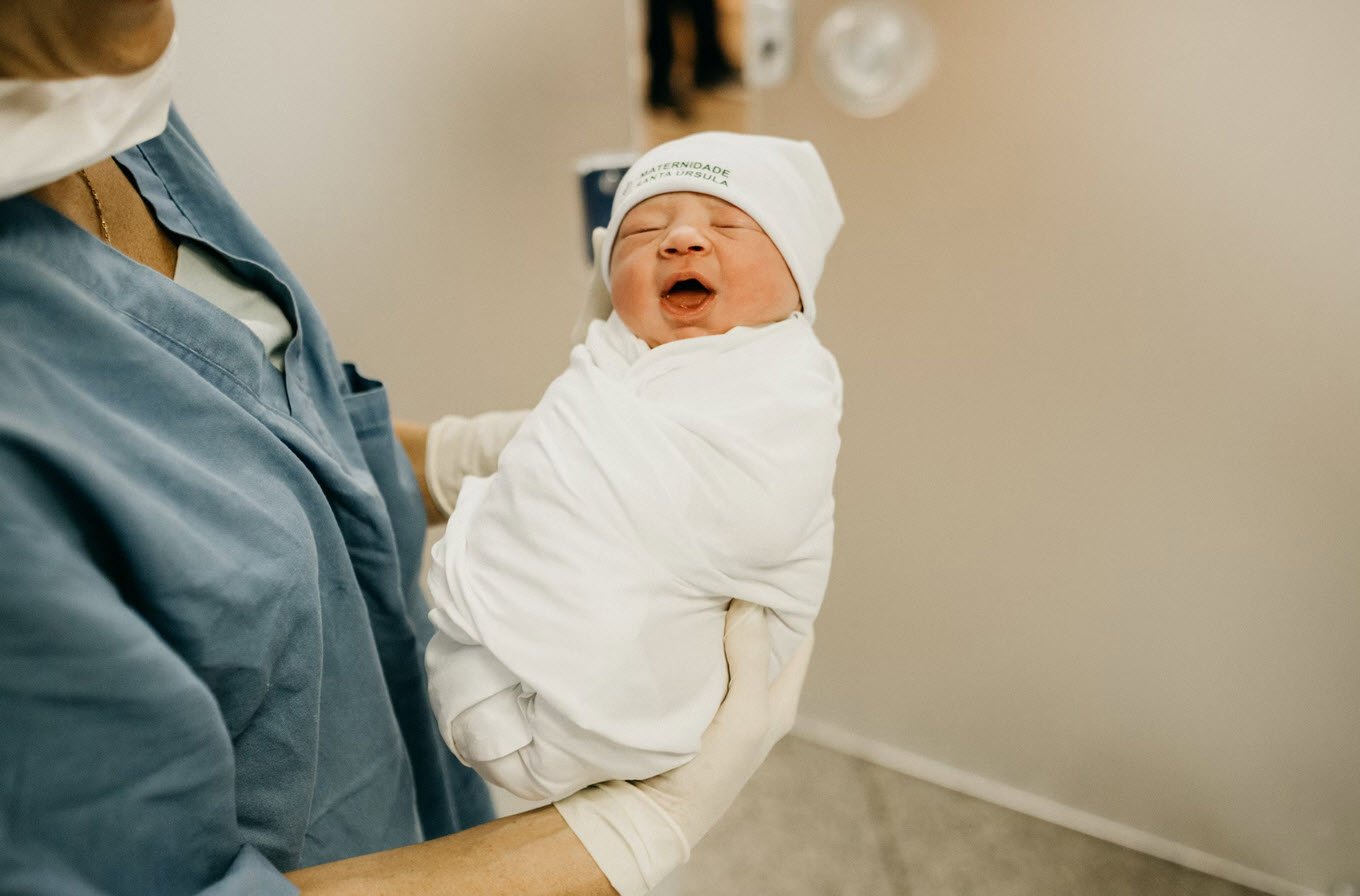
Pregnancy usually lasts about 40-41 weeks from the first day of your last menstrual period to your due date. During pregnancy and childbirth, you may see and hear lots of different medical terms.
Health professionals are notorious for abbreviating diseases, terms and meanings etc. and the Midwifery are no exception. In fact, they may be the worst of all.
There are many relevant words and abbreviations that you will most likely come across in the course of your pregnancy. This list is by no means exhaustive but hopefully, it may help you understand some of the dialogue that occurs. Like all areas of pregnancy, medicine, and childbirth has a number of specialised key terms, many of which you will hear during your own pregnancy and labour and the birth of your baby.
The following list provides important terms and definitions related to Pregnancy:
1. Albumin
A protein that can appear in your urine when you are pregnant. It can be a sign of an infection or pre-eclampsia. Your midwife will test your urine for albumin at your antenatal check-ups.
2. Amniocentesis
A test in which a thin needle is inserted into the uterus through the abdominal wall to take a Sample of the fluid surrounding the baby. The fluid is then tested for certain chromosomal and Genetic disorders.
An amniocentesis is usually carried out between 15 and 18 weeks into your Pregnancy. It may be used later in pregnancy to find out if your baby’s lungs are mature.
3. Amniotic sac
The bag of fluid that surrounds and cushions your baby in the uterus. Before or during labouthsac breaks and the fluid drains out. This is called the ‘waters breaking’.
4. Anaesthetics
Medicines that reduce or take away pain..
5. Antenatal
This literally means ‘before birth’ and refers to the whole of pregnancy, from conception to birth.
6. Baby blues
Feeling sad or mildly depressed a few days after your baby is born. The baby blues are very Common – eight out of 10 new mothers feel like this. They can be caused by hormone Changes, tiredness or discomfort and usually only last a week. More severe depression or anxiety that lasts longer than a week could be postnatal depression.
7. Balanced diet
A diet that provides a good balance of nutrients.
8. Bereavement
The loss of a person. Coping with a bereavement can be particularly difficult if you are Pregnant or have just had a baby, and even harder if it is your baby who has died.
9. Birth plan
A written record of what you would like to happen during pregnancy, labor and childbirth.
10. Breech birth
When a baby is born bottom rather than head first.
11. Caesarean section
An operation to deliver a baby by cutting through the mother’s abdomen and then into her Uterus. If you have a caesarean, you will be given an epidural or general anaesthetic.
12. Catheter
A thin, flexible, hollow plastic tube that can be used to perform various diagnostic and/or therapeutic procedures. Catheters may be used for the injection of fluids or medications into an area of the body or for drainage, such as from a surgical site. They are also frequently used to allow physicians to access the body with surgical instruments.
13. Cervix
The neck of the uterus. It is normally almost closed, with just a small opening through which blood passes during monthly periods. During labor, your cervix will dilate (open up) to let your baby move from your uterus into your vagina.
14. Chorionic villus sampling
A test to detect genetic disorders, particularly chromosomal disorders such as Down’s syndrome. It is usually carried out at around 11 weeks.
15. Colostrum
The milk that your breasts produce during the first few days after your baby is born. It is very Concentrated and full of antibodies to protect your baby against infections. Colostrum has a rich, creamy appearance and is sometimes quite yellow in color.
16. Conception
The start of a pregnancy, when an egg (ovum) is fertilized and then moves down the fallopian Tube to the uterus, where it attaches itself to the uterus lining.
17. Contraception
Contraception prevents or reduces your chances of getting pregnant.
18. Cot death
The sudden and unexpected death of an apparently healthy infant during their sleep.
19. Down’s syndrome
A lifelong condition caused by an abnormal number of chromosomes. People with Down’s syndrome have some degree of learning disability and an increased risk of some health problems. It also affects their physical growth and facial appearance.
20. Ectopic pregnancy
An ectopic pregnancy occurs when a fertilized egg begins to grow in the fallopian tube, cervix, ovaries or abdomen, not in the lining of the uterus. The fertilized egg cannot develop properly and has to be removed.
21. Embryo
The term used for the developing baby in the very early weeks up until eight weeks Of pregnancy.
22. Entonox
A form of pain relief offered during labor. It is a mixture of oxygen and another gas called nitrous oxide, which is breathed in through a mask or mouthpiece.
23. Epidural
An anaesthetic that numbs the lower half of the body. It can be very helpful for women Who are having a long or particularly painful labor, or who are becoming very distressed. A thin catheter is placed between the vertebrae so that medicine can be delivered to the nerves in the spinal cord.
24. Episiotomy
A surgical incision made in the area between the vagina and anus (perineum). This is done during the last stages of labor and delivery to expand the opening of the vagina to prevent tearing during the birth of the baby.
25. Fallopian tubes
Branch-like tubes that lead from the ovaries to the uterus. Eggs are released from the ovaries into the fallopian tubes each month. Fertilisation takes place in one of the fallopian tubes.
26. Fertilisation
Fertilisation takes place if a man’s sperm joins with a woman’s egg and fertilises it in the fallopian tube.
27. Fetal alcohol syndrome (FAS)
A syndrome that can cause children to have restricted growth, heart defects and facial abnormalities as well as learning and behavioural disorders. It is caused if your baby is exposed to too much alcohol (via the placenta) when they are in the uterus.
28. Fetus
The term used for the developing baby from week eight of pregnancy onwards.
29. Folic acid
One of the B group of vitamins, which is found naturally in foods, including green leafy vegetables, fortified breakfast cereals and brown rice. Folic acid is important for pregnancy as it can help prevent birth defects known as neural tube defects. If you are pregnant or trying to get pregnant, you should take a 400 microgram folic acid tablet every day until you are.
30. Fontanelle
A diamond-shaped patch on the front and top of a baby’s head where the skull bones have not yet fused together. During birth, the fontanelle allows the bony plates of the skull to flex, so that the baby’s head can pass through the birth canal. The bones usually fuse together and close over by a child’s second birthday.
31. Formula milk
Cows’ milk that has been processed and treated so that babies can digest it. It comes in powder or liquid form.
32. Fundus
The top of the uterus.
33. Haemoglobin (Hb)
Haemoglobin is found in red blood cells and carries oxygen from the lungs to all parts of the body. Pregnant women need to produce more haemoglobin because they produce more blood. If you don’t produce enough, you can become anaemic, which will make you feel very tired. Your haemoglobin levels are tested during antenatal check-ups.
34. Home birth
Giving birth at home, with care provided by a midwife. This is usually planned!
35. Induction
A method of artificially or prematurely stimulating labor. A baby can be induced if they are getting too big, if the pregnancy has gone past the 42-week mark or if there are health risks to either the baby or the mother if the pregnancy continues.
36. Jaundice
The development of a yellow colour on a baby’s skin and yellowness in the whites of their eyes. It is caused by an excess of the pigment bilirubin in the blood. Jaundice is common in newborn babies and usually occurs approximately three days after birth. It can last for up to two weeks after birth or up to three weeks in premature babies. Severe jaundice can be treated by phototherapy, where a baby is placed under a very bright light. Babies who are jaundiced for longer than two weeks should be seen by a doctor as they may need urgent treatment.
37. Lanugo
Very fine, soft hair that covers your baby at approximately 22 weeks. The lanugo disappears before birth.
38. Mastitis
An infection in the breasts caused by blocked milk ducts. Symptoms include hot and tender breasts and flu-like symptoms.
39. Maternity team care
A team of midwives, obstetricians, anaesthetists, neonatologists and other specialists who provide care to women who have complex pregnancies.
40. Meconium
The first stools that your baby passes. Meconium is made up of what a baby has ingested during their time in the uterus, including mucus and bile. It is sticky like tar and has no odour.
41. Midwifery care
Care for pregnant women where the midwife is the lead professional. Midwifery care is suitable for women who have an uncomplicated pregnancy.
42. Morning sickness/nausea
Morning sickness affects more than half of all pregnant women. Symptoms include nausea or feeling sick, as well as actually being sick. Morning sickness can occur at any time of the day, though it occurs most often in the morning because blood sugar levels are low after a night without food. The symptoms usually start after the first month of the pregnancy, peaking in weeks five to seven, and continuing until weeks 14 to 16.
43. Neonatal care
The care given to sick or premature babies. It takes place in a neonatal unit, which is specially designed and equipped to care for them.
44. Nuchal translucency scan
An ultrasound scan to help identify whether you are at risk of having a baby with Down’s syndrome. The scan is carried out at 11 to 13 weeks of your pregnancy and measures the amount of the nuchal translucency, which is fluid behind the neck of the baby. Babies at risk of Down’s syndrome tend to have a higher amount of fluid around their neck. The scan may also help confirm both the accuracy of the pregnancy dates and whether the baby has any other health problems.
45. Obstetric cholestasis
A potentially dangerous liver disorder. Symptoms include severe generalised itching without a rash, particularly in the last four months of pregnancy.
46. Obstetrician
A doctor specialising in the care of women during pregnancy and labour and after the birth.
47. Oedema
Another word for swelling, most often of the feet and hands. It is usually nothing to worry about, but if it gets worse suddenly it can be a sign of pre-eclampsia.
48. Ovulation
Ovulation occurs when an egg (ovum) is released from one of a woman’s ovaries during her monthly menstrual cycle. If the egg is fertilised during this time, she will get pregnant. This is the time of the month when you are most likely to conceive.
49. Paediatrician
A doctor specialising in the care of babies and children.
50. Perinatal
The time shortly before and after the birth of a baby.
51. Perinatal mental health
Mental health problems that develop during pregnancy and that can last for up to one year after childbirth.
52. Placenta
The organ attached to the lining of the uterus, which separates your baby’s circulation from your circulation. Oxygen and food from your bloodstream are passed to your baby’s bloodstream through the placenta and along the umbilical cord. Waste is also removed this way.
53. Postnatal
The period beginning immediately after the birth of a baby until they are about six weeks old.
54. Postnatal care
The professional care provided to you and your baby, from the birth until your baby is about six to eight weeks old. It usually involves home visits by midwives to check that both mother and baby are well. Classes may also be available.
55. Postnatal depression
Feelings of depression and hopelessness after the birth of a baby. These feelings are more severe than the ‘baby blues’. Postnatal depression affects one in 10 women and can be serious if left untreated.
56. Pre-eclampsia
A condition that only occurs during pregnancy. Symptoms include high blood pressure, protein in urine, bad headaches, vision problems and the sudden swelling of the face, hands and feet. It usually develops after the 20th week of pregnancy but can occur earlier. Although most cases are mild and cause no trouble, it can be serious for both mother and baby.
57. Premature birth
The birth of a baby before the standard period of pregnancy (37 weeks) is completed.
58. Premature labour
When labour starts before 37 weeks of pregnancy.
59. Rhesus disease
A woman who is rhesus negative (see below) can carry a baby who is rhesus positive if the baby’s father is rhesus positive. This can cause problems in second or later pregnancies. If she gets pregnant with another rhesus positive baby, the immune response will be quicker and much greater.
The antibodies produced by the mother can cross the placenta and attach to the D antigen on her baby’s red blood cells. This can be harmful to the baby as it may result in a condition called haemolytic disease of the newborn, which can lead to anaemia and jaundice.
60. Rhesus negative
People with a certain blood type are known as rhesus negative. It means that they do not Have a substance known as D antigen on the surface of their red blood cells. This can cause Problems in second or later pregnancies.
61. Rhesus positive
People with a certain blood type are known as rhesus positive. This means that they have a substance known as D antigen on the surface of their red blood cells.
62. Rubella (German measles)
A virus that can seriously affect unborn babies if the mother gets it during the early weeks of pregnancy. Most women have been immunised against rubella, so they are not at risk.
63. Ultrasound/scans
An imaging technique that uses high-frequency sound waves to create an image of your baby in the uterus. It shows your baby’s body and organs as well as the surrounding tissues. Also called sonography, this test is widely used to estimate delivery dates and check that your developing baby is healthy and growing normally.
64. Umbilical cord
The cord that attaches the baby to the placenta, linking the baby and mother. Blood circulates through the cord, carrying oxygen and food to the baby and carrying waste away again.
65. Vernix
A sticky white coating that covers a baby when it is in the uterus. It mostly disappears before birth but there may be some left on your baby when they are born.
66. Vertebrae
Your spine is made up of 33 irregularly shaped bones called vertebrae. Each vertebra has a hole in the middle through which the spinal cord runs.
- Pregnancy: After Birth: Should You Return to Work?
- What Foods to Skip While Breastfeeding?
- Managing Exposure to Chickenpox and Rubella in Pregnancy
- Common Health Issues in Babies After Birth
- Common Issues During the Second Month of Pregnancy
- An Intimate Pregnancy – A Brief Guide
- Urinary and Vaginal Problems During Pregnancy – A Brief Guide
- 8 Common Congenital Problems in Newborns You Should Know
- 6 Common Issues During the First Month of Pregnancy
- The Do’s and Don’ts of Safe Exercise in Pregnancy








